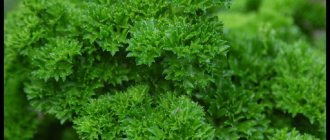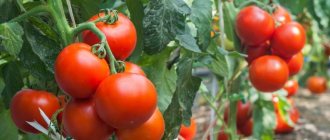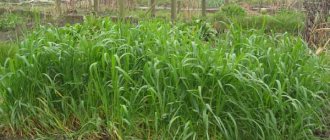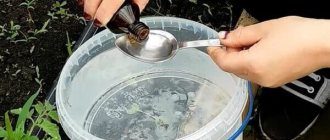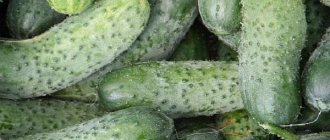List of the easiest vegetables to grow in the garden
The best solution for farmers who do not have experience or time is to plant unpretentious plants. TOP 11 garden vegetables that do not require special care:
- Horseradish. Leader in unpretentiousness. It grows on any soil, prefers moderate light and shade, and can be combined with many types of vegetables in the garden.
- Spinach, lettuce, watercress, lettuce. They grow actively and do not require abundant watering or weeding. They love open, sunny areas and do not take up much space in the garden.
- Radish. It grows and ripens quickly and tolerates cold snaps and frosts well. It is used for spring planting, since in summer, when the day is long, all nutrients go not to the root crop, but to the tops.
- Beans. It grows so quickly that it is often compared to a weed. It can not only produce useful fruits, but also perform a decorative function in the garden.
- Peas. Having fallen into the ground in several peas, it quickly grows along the support and pleases with a harvest of green pods.
- Potato. Growing root crops is not difficult if you do not try to plant the entire garden with it, but select a small plot. The main thing is to plant on time, periodically hill up and water moderately.
- Zucchini, zucchini, squash. These related annual crops grow quickly, bloom beautifully and abundantly, and bear fruit in the garden until frost.
- Beet. Loves the sun, but can ripen in slight partial shade. Suitable for mixed plantings next to onions, potatoes or strawberries.
- Chard (chard or spinach beet). Saturates the soil with micronutrients, tolerates light frosts and short-term drought.
- Rhubarb. This cold-resistant and unpretentious perennial can grow in both the southern and northern regions. Does not require replanting for 10-15 years, tolerates bright light and partial shade equally well.
- Green onions. Onions can easily be obtained from an old onion or onion set. Individual bulbs can be planted in the garden between other crops, in a balcony box and a flower pot. Regular watering is required to grow green mass.
Even a novice summer resident who is little familiar with the intricacies of agricultural technology can reap a good harvest of these vegetables.
What plants to plant in partial shade
Surprisingly, you can grow many different plants in partial shade and improve this corner of the garden. There are a sufficient number of ornamental and vegetable crops that do well in partial sunlight. Partial shade is considered when an area is partially illuminated by the sun during the day, and it disappears for 3-4 hours or appears in the first or second half of the day.
What flowers can be planted in partial shade?
There are many shade-loving flowers that do well in partial shade, when sunlight partially penetrates. The main thing is to remember to water regularly and ensure good drainage in advance. Such flowers love moisture, but cannot tolerate stagnation, and it evaporates more slowly than in the sun.
Usually, in partial shade, plants are not sown with seeds, but rather with shoots and rhizomes, bulbs and tubers, since there is not enough light for seeds to germinate.
It is important to calculate the flowering time , if in summer and autumn, then plant in spring, and if in spring, then plant in autumn.
In partial shade, alpine slides turn out beautiful; you can plant the following flowers on it:
- Forget-me-not or Brunneru. This is a very beautiful spring plant. In May, small pale blue flowers bloom. The plant blooms again during the season at the end of summer until the coldest weather.
- Hosta or Funkiy. The plant has unusual and interesting leaves. It blooms at the end of July for a couple of weeks.
- Astilbe. It blooms very spectacularly at the end of summer. The large, glossy, shiny leaves of the plant look interesting.
- Ferns. They are distinguished by a variety of leaf shapes and their colors. Popular ferns are maidenhair, Japanese, ostrich, nocturnal, and multirow bristlecone.
- Irises. Flowers are combined with ferns. Both yellow and purple irises look equally impressive.
- Rhododendrons. The flowers bloom lush and bright. An area in partial shade becomes more cheerful and effective.
- Bought. The plant attracts with its large, unusually shaped leaves. In shade and partial shade the flower feels great.
- Lilies of the valley. In spring, these first flowers will fill the garden with fragrance and beauty.
- Bells. These simple flowers survive well in low light conditions.
- Calendula. This useful plant needs 2-3 hours a day to actively grow, bloom and develop.
Is it possible to plant roses in the shade?
Many gardeners love to grow roses in the garden. These flowers look spectacular. But often not the most favorable places are allocated for flower beds, including in partial shade. Partial shade is not the most suitable place for a rose garden, since roses are light-loving plants.
However, if desired, it is possible to plant rose bushes in partial shade. But in order for the plants to feel good, follow a number of growing recommendations:
- carry out constant pruning so that they do not stretch due to lack of light;
- provide the roots with space so that the roots do not compete with the roots of trees or shrubs;
- Carry out periodic spraying with copper sulfate and fungicides, for example, Fitosporin. Carry out prevention against aphids. See how to get rid of aphids on your property.
- provide fertile soil and good drainage, as roses love moisture but do not tolerate waterlogging.
What to plant vegetables in partial shade
There are many vegetable crops that thrive in the partial shade of trees and produce rich harvests. These include:
- sorrel;
- garlic;
- carrot;
- beans, peas and other legumes;
- red beets;
- root parsley;
- parsnip.
Melissa and mint take root well in the shade. You can plant physalis. In summer, greenery will decorate the garden, and in autumn you can enjoy sweet berries.
Trees and shrubs growing in partial shade
Trees and bushes can not only provide shade themselves, but also grow in partial shade from fences and country houses. Planting such plants in a place where little sunlight penetrates allows you to ennoble the space, create a relaxation area and get a harvest.
Some of them are shade-loving and feel great with a lack of light, others will grow, turn green, even bloom, but will not be able to get a harvest.
Grows and bears fruit well in partial shade:
- Cherry. It grows well and bears fruit in the most secluded places.
- Cherry plum. Despite the fact that it is a southern plant, it tolerates partial shade and is unpretentious in care.
- Plum. Blue varieties of fruit trees are suitable for partial shade. But you shouldn’t plant yellow ones, there will be no harvest.
- Apple tree. The tree does not do well only in lowlands and wetlands.
Among the shrubs that tolerate partial shade are:
- all types of currants;
- raspberries, especially Arctic ones;
- blackberries;
- black elderberry;
- barberry;
- honeysuckle;
- viburnum;
- rowan;
- dogwood.
Gooseberries feel good in the shade. But watch out for thickening. Pruning gooseberries and spraying against fungi and pests more often.
A shady place can be enriched not only with garden crops, but also with decorative ones. An excellent option to plant thuja. Western thujas are the most unpretentious plants that retain their decorative qualities even with a lack of light. Thujas grow not only in the shade, but also in close groundwater.
In general, coniferous trees, spruce, fir, yew, are an excellent option for planting in partial shade, since in natural conditions they grow as if there is a lack of sunlight.
List of shade-tolerant vegetables for the garden
When the area of a garden or cottage is limited, and the most illuminated areas are reserved for the main crops, the question arises of which vegetables, herbs and berries grow in the shade. Many cultivated plants can tolerate a lack of sunlight, and some of them prefer to grow in dense shade.
Shade-tolerant vegetables for the garden include:
- climbing and bush (asparagus) beans;
- jusai (Chinese or allspice onion);
- oregano;
- cilantro (coriander);
- leaf salad;
- Melissa;
- mint;
- parsnip;
- parsley;
- table beets;
- celery;
- thyme (thyme);
- dill;
- garlic;
- wild garlic;
- chives;
- sorrel;
- tarragon (tarragon).
In the shade, where sunlight is rare, the following develop more actively:
- strawberries;
- watercress;
- leaf mustard;
- chard;
- arugula;
- horseradish;
- spinach.
Dzhusai is a plant that requires virtually no care. Has a garlicky taste and aroma
Oregano – gives dishes an original taste
Cilantro (coriander) – contains 11 types of essential oils. The plant is a good honey plant
Leaf lettuce is a moisture-loving, cold-resistant and early-ripening plant.
Melissa is an excellent honey plant and seasoning. Included in the set of essential herbs of traditional medicine
Mint – leaves are rich in menthol, which has local analgesic, antispasmodic and antiseptic properties
Parsnip is a root vegetable with an unusual sweetish taste and pleasant aroma.
Parsley is a plant that contains more vitamin C than lemons, and more vitamin A than carrots.
Celery is used in food for weight loss
Dill can be used not only as a seasoning, but also to prepare a decoction and tincture for bloating, intestinal colic and constipation.
Tarragon - has a strong but pleasant aroma, tastes a little like pineapple
Thyme - in addition to seasoning, is used to rejuvenate the skin and restore the nervous system
Shade-loving vegetables for the garden are a godsend for summer residents. Such crops will grow well in the openwork shade of garden trees and shrubs, tree trunks and mixed plantings with leafy and tall neighbors.
What to plant in the shade at the dacha
There are plants that tolerate conditions where sunlight hits the site for a couple of hours. If you follow agricultural technology, even in such conditions it is possible to grow plants and get a harvest.
What flowers to plant in the shade
Low illumination during the day is well tolerated by:
- Badan. Loves moisture, grows in the shade, but does not bloom.
- Day-lily. Grows quickly in the shade and loves moist soil.
- Forget-me-nots. Quickly covering the ground in the shade, simple and unpretentious flowers decorate the garden, alpine hill with their beauty.
- Periwinkle. Planted to quickly cover the ground in the shade of trees or near a fence.
- Loosestrife.
But peonies do not grow well in the shade. These plants love the sun; in extreme cases, partial shade is allowed. Peonies grow in dense shade, but do not bloom.
The queen of shade is the hydrangea. The perennial shrub blooms beautifully in the shade. The plant combines openwork, massiveness and elegance. The bush gives volume, splendor and a bright scattering of flowers.
Video: What flowers can be planted in the shade
Vegetable bed in the shade
Some vegetables can also be grown in full shade. Shade-tolerant plants include:
- cucumbers;
- lettuce;
- chives;
- rhubarb;
- radish;
- beet.
Cauliflower and white cabbage grow well in a little shade. Shaded areas can also be used for growing herbs: parsley, dill, celery, onions, lettuce and sorrel.
What fruit trees to plant in the shade
If there is no more space on the site, except shaded, then it is recommended to plant:
- apple trees;
- viburnum;
- rowan;
- hazel;
- honeysuckle.
Plant the same fruit trees in the shade as in partial shade, but pay more attention to the prevention of fungal diseases and parasites.
What to plant in the shade at the dacha from shrubs
Among the berry bushes you can choose for the shady part of the garden plot:
- blackberries,
- raspberries,
- rose hip,
- gooseberry,
- red currants,
- elderberry
Some are trying to plant empty spaces in the shade with strawberries. However, the berry loves light. The more sun the strawberries receive, the tastier and larger the berries become.
Video: Shade-loving trees and shrubs
Unusual, rare and miracle vegetables in the garden
The more different vegetables you plant in the garden, the more interesting it will be in the summer on the plot. With some effort, you can grow not only traditional crops, but also rare, outlandish plants:
- Pepino (melon pear). In temperate climates it is grown as an annual. It produces fruits that taste like a mixture of melon, pumpkin and cucumber.
- Melotria. Fresh roots and canned fruits are used for food. An actively climbing vine, strewn with unusually colored fruits, is often used for vertical gardening.
- Tladianta (red cucumber). The plant comes from the Ussuri taiga, so its tubers can overwinter in the soil. The taste of the fruit is reminiscent of a carrot-pumpkin cocktail.
- Luffa. Young fruits are suitable for eating, and ripe ones are suitable for making soft and delicate washcloths.
- Romanesco (cauliflower variety). It is grown no more difficult than white cabbage, but has a delicate nutty taste.
- Purple (blue) potatoes. The pulp of root vegetables is colored deep purple. Mashed potatoes or French fries made from blue root vegetables have a pleasant potato flavor.
With proper care, miracle vegetables planted in the country house or in the garden will produce a harvest of unusual fruits and will become the envy of the neighbors.
Berry bushes for dimly lit areas
A large number of varieties of berry bushes with sweet fruits are suitable for planting in dimly lit areas. Shade-loving plants appeared due to the fact that in the natural environment, blackberry, raspberry, rowan, honeysuckle and viburnum bushes grew in the forest, under the cover of treetops.
You can plant berry bushes in the shade of your house to get juicy fruits throughout the summer.
Blackberry
The blackberry bush can be planted in the shade of a tree or fence; it is unpretentious in relation to sunlight, but requires good watering.
If you water the blackberries abundantly after planting and fertilize the soil with organic substances, such as pine ash, the bush will produce a large number of fruits.
Shade-grown blackberries will ripen slightly later than sun-grown blackberries, but the size and flavor of sun and shade berries will be the same.
Raspberries
The raspberry bush grows well and bears fruit in poorly lit areas of the garden or vegetable garden. It can be planted along the fence, in the shade of grapes or fruit trees.
Raspberries ripened in the shade are juicier, larger and sweeter than those grown in a well-lit place.
Currant
Currant bushes can not only be grown in shady areas, but are even necessary, since a bush planted in the sun in the southern regions will burn. Currants love shade, as in the wild they grow in fairly dark and swampy areas.
You may be interested in: Planting strawberries under film
In partial shade, large and sweet red currant berries will grow on the bush, but they will ripen a little slower than on bushes planted in a well-lit place in central Russia.
Kalina
Light-loving viburnum shrubs can be grown in partial shade, as they will not die from lack of light. However, lack of sufficient sunlight will cause the volume of crops on the branches to decrease.
In a shaded area, viburnum will turn from a fruitful plant into a decorative one.
Rose hip
In addition to the fact that rosehip blooms beautifully, its fruits are very beneficial for health. You can plant shrubs in shady areas of the garden, as they easily adapt to low amounts of sunlight.
Note: during flowering, rose hips attract bumblebees to the site, which are an important part of the ecosystem and are useful for the garden and greenhouses.
Advantages of mixed plantings
Rational use of usable space and proper placement of garden crops will help you get a generous harvest. Compared to the traditional method, mixed planting of vegetables in the garden has many advantages:
- Saves space in the garden.
- Vegetables and herbs from different families pull different nutrients from the soil, which prevents soil depletion.
- Green manure crops planted on compacted beds improve the structure of the soil and enrich it with nitrogen.
- Companion plants often act as living mulch and serve as protection against drying out and erosion of the soil.
- The proximity of different crops helps to improve the taste and increase the size of ripening fruits.
- Compacted plantings leave little room for weeds to grow.
- Properly selected accompanying crops will restrain the development of fungal diseases, repel pests with their aroma and attract beneficial insects. For example, onions will repel carrot flies, and carrots will repel onion flies.
In mixed (combined, compacted) plantings, the main crop and a satellite plant are planted. These can be green manure, accompanying vegetables, herbs and even flowers - they will create favorable conditions around the main neighbor for the growth and ripening of fruits.
Using Alternative Techniques
It is also possible to use mixed planting techniques.
The essence of the method is to grow several (usually 2-3) types of plants in close proximity to each other. In this case, one type of plant is called the main one; it tends to take up more space and, as a result, creates a lot of shade. In this shade, auxiliary species are planted; they are, as a rule, smaller in size, shade-loving, mature quickly and perform some secondary function useful for the main species (for example, they protect it from parasites). In turn, the main plants provide them with protection from the harmful rays of the sun, which can cause burns to the foliage of satellite plants. Examples of such artificial “symbiosis” are growing tomatoes, onions, garlic or lettuce in the shade. Lettuce and radishes are ideal neighbors for a huge number of plants. Cucumbers go great with dill or garlic. Many legumes are also versatile plant support plants; some of their species can be used as hedges.
However, we should not forget that some minor shade-loving crops are completely incompatible with the main ones. For example, onions and sage or tomatoes and dill cannot stand being next to each other at all. Another example of an alternative approach is planting vegetable crops in the tree trunk zone. In mid-spring, various shade-loving vegetables are planted next to tree trunks to protect against harmful insects. These can be climbing varieties of tomatoes or cucumbers. The option of using legumes is not excluded; they also enrich the soil with nitrogen for the following season. In turn, tree crowns help tomatoes by protecting them from precipitation.
Rules for mixed planting of vegetables
When planning mixed planting of vegetables in your garden, you need to be guided by the basic principles of their placement:
- Crops belonging to the same family cannot be planted in the same bed. They are characterized by the same diseases, pests and essential nutrients, so the risk of infection, crop loss and land depletion will increase several times.
- Vegetables need to be placed so that light-loving plants are not shaded by their neighbors in the garden, and shade-loving plants are not exposed to the scorching rays of the sun. Tomatoes, eggplants, peppers, cucumbers, corn, melon, and watermelon prefer bright sunlight. Cabbage, radishes, turnips, radishes, beans, carrots, onions and garlic require moderate lighting.
- Combine crops with different ripening periods. Early ripening crops include Chinese cabbage and kohlrabi cabbage, early varieties of cucumbers and potatoes, onions, radishes and lettuce. Compared to them, fruit ripening occurs later in tomatoes, zucchini, pumpkin, peppers, beets, eggplants, late varieties of cabbage and cucumbers.
- Plant in the garden only those crops that are compatible with each other. The compatibility table for vegetables in the garden will help you navigate when choosing neighbors.
It is useful to plant fragrant herbs on compacted beds, which with their strong aroma will repel pests and attract pollinating insects. In a combined planting, lemon balm, oregano, mint, coriander, marjoram, basil or sage will not be out of place.
General questions about planting plants in the shade
Therefore, it is recommended not to just choose what to fill the shadow “voids” in the garden, but to approach the issue scientifically, starting with the most important thing - analyzing the situation happening in the garden during daylight hours.
It would be good to draw a detailed plan of the site with all the buildings and large trees, as well as areas for planting certain vegetables; on this plan it is necessary to mark the zones of illumination and shade zones during the day, for example, hourly. This will make it possible to once again check whether certain crops are planted correctly. It is possible that the site will require minor redevelopment. Once the areas and their degree of illumination have been determined, you can begin selecting shade-loving crops for their cultivation. It should be noted right away that many shade-loving vegetables for the garden sometimes place excessive demands on the care and soil on which they grow. Indeed, if the intensity of sunlight is insufficient to provide the plant with carbohydrates through its own synthesis, it is necessary to take energy and raw materials from somewhere to ensure its existence. In this regard, clay soils are much more preferable, since they almost do not require the use of various fertilizers. Loams or sandstones are a little worse; The worst option for growing shade-loving vegetables are salt licks, since they require constant application of fertilizers.
As for soil acidity, most shade-loving vegetables prefer slightly acidic soils. Acidic and slightly acidic soils are ideal for growing nightshades, in particular potatoes.
Sequence of planting vegetables in the garden
Rotating crops in the garden helps increase yields and protect plants from diseases and pests. Garden vegetables should be placed in a new place every year, taking into account the principles of crop rotation:
- Do not plant plants of the same species and family one after another.
- Return vegetables to their original place after 3-4 years.
- Alternate plants with shallow and deep-penetrating roots annually.
- Take into account the ability of crops to resist weeds, alternating vegetables with well-developed, fast-growing foliage and plants with a small rosette of tops.
- In the garden where vegetables were harvested in late autumn, do not plant plants that require early planting
- Divide the garden into 2 zones so that in one of them you can grow crops that prefer manure as a top dressing, and in the other - vegetables that do not tolerate this type of organic matter.
- To saturate the soil with nitrogen and improve its structure, it is necessary to include legumes and green manure in the crop rotation.
To avoid possible confusion, experienced summer residents recommend drawing up a site plan annually, taking into account the rules of rotation and compatibility of vegetable crops. (link to the table of alternating planting of vegetables in the garden)
General rules for planting in a small area
- Fruit trees are placed along the fence around the perimeter of the site.
- Shrubs are planted in rows in the center of the site, thereby delimiting it into zones.
- For vegetables and flowers, the remaining free places are chosen, taking into account which of them are shade-loving and which prefer the sun's rays.
- Vegetables that love shade, as a rule, compensate for the lack of sun with increased requirements for the composition of the soil and its moisture. Therefore, they need to be regularly watered and fed, especially during the ripening period.
List of vegetables for planting in the garden for the winter
To plant vegetables in the garden for the winter, it is important to carefully select planting material. Here is a list of crops that are likely to survive winter frosts well and will delight you with a good harvest in the spring:
- Onion
- Garlic
- Radish
- Beet
- Carrot
- Dill
- Parsley
- Cilantro
- Spinach
- Salad
- Celery
- Parsnip
- Coriander
- Sorrel
It should be remembered that when planting vegetables in the garden for the winter, planting material is sown only dry; the seeds cannot be soaked. In addition, the total number of seedlings should be one third greater compared to spring plantings. This is due to the fact that some of them will not germinate.
In spring, the main problem for seedlings most often becomes the dense crust of soil compacted over the winter, which does not allow the sprouts to break through to the sun. Therefore, after the snow melts, you need to carefully loosen the planting areas in the garden, breaking the crust if it has formed.
Rate this article:
Preparing seeds and seedlings
Different summer residents solve this issue in different ways. It’s easier for some to trust specialty stores that have proven themselves well among experienced neighbors. But there are brave souls who grow their own seedlings in greenhouses all winter from seeds collected on their own plot. When estimating the required quantity of these same seeds and seedlings, you need to proceed, again, from the size of the plot, the number of people you want to feed with fresh vegetables from your own garden, and the average consumption of these vegetables per person. It is necessary to select varieties of vegetables taking into account the natural and climatic zone and the illumination of the site. This is not as expensive as burning shade-loving vegetables for the garden under the scorching sun in an open area. By gaining experience in planting and growing vegetables, excellent yield results can be achieved without increasing or changing the shape of the plot.
Similar chapters from other books:
Stone fruits
Stone fruits Stone fruits consist of a huge number of species and varieties of plants. Among them, the Volga region varieties of plums, cherries and sweet cherries stand out. Cherry Fig. 14. Cherry.Kent. Kent is characterized by low winter hardiness and good yield. Fruit
Berry crops
Berry crops Berry crops have always been in great demand among gardeners. This is due to some valuable qualities that they possess. Berry crops bring large harvests every year, and caring for them is easy. Volga gardeners willingly
Medicinal crops
Medicinal crops In modern gardening, a large role is given to ornamental plants that can be used for medicinal purposes. They contain a significant amount of microelements and antibiotics that have a beneficial effect on the body.
Green crops
Green crops 776. Who benefits from spinach? What a wonderful garden green! Widely used in cooking all over the world, except ours. You could write a whole treatise on the beneficial properties of spinach. Spinach chlorophyll is close in structure to blood hemoglobin, therefore
Cabbage crops
Cabbage crops 831. What are the benefits of white cabbage? Its fiber improves intestinal motility, that is, it promotes the passage of food through the intestines. Cabbage has bactericidal properties, therefore it suppresses putrefactive microflora of the stomach and intestines.
Nightshade crops
Nightshade crops 841. Can green tomatoes be eaten? Green tomatoes contain the plant poison solania, which is not so terrible, but it’s still better not to eat green tomatoes raw. Salted, fried or canned green tomatoes no longer contain solanine. And here
Pumpkin crops
Pumpkin crops 172. What kind of soil and what conditions do pumpkin crops need? Pumpkin crops include cucumber, watermelon, melon, zucchini, squash, crookneck, lagenaria, and loofah. All pumpkin plants do not like acidic soils, cold soil, and cannot tolerate even slight frosts. Them
Nightshade crops
Solanaceous crops 192. Why can’t nightshade crops (tomato, pepper, eggplant, physalis) be given excess nitrogen before the first ovaries appear? With excessive doses of nitrogen in the initial period of development, they shed buds and flowers. In addition, these plants require
Cabbage crops
Cabbage crops 234. Cabbage first stores a supply of nutrients in the covering leaves, like a storeroom, to be used when planting a head of cabbage. Typically, the head of cabbage begins to set when there are 7–9 covering leaves. For some reason, many people remove these large green coverts.
Green crops
Green crops Onions 241. Is it possible to cut off the feathers of onions? You won’t get a big onion if you “rob” the onion by taking away its feather. All plants first, like in a pantry, store a supply of nutrients in the leaves, from which they then take this supply for growth.
Green crops
Green crops 394. Who benefits from spinach? What a wonderful garden green! Widely used in cooking all over the world, except ours. You could write a whole treatise on the beneficial properties of spinach. Spinach chlorophyll is close in structure to blood hemoglobin, therefore
Leguminous crops
Legumes 439. What is healthy about green peas? Green peas are a good supplier of vegetable protein, carbohydrates, vitamins, and polysugars. In terms of calories, it is 1.5–2 times higher than other vegetables. It is very useful to eat green peas for diseases.
Cabbage crops
Cabbage crops 447. What are the benefits of white cabbage? Its fiber improves intestinal motility, that is, it promotes the passage of food through the intestines. Cabbage has bactericidal properties, therefore it suppresses putrefactive microflora of the stomach and intestines.
Special vegetable
In the south, summer residents have a special garden vegetable - garlic. It is often planted near peaches and nectarines to protect the trees from leaf curling in hot climates. You just need to dig up the garlic very carefully so as not to damage the roots. It is also planted in the shade of gooseberry bushes, black and red currants. For the same purposes, the southern perennial grass dzhusai, similar to wild garlic, is planted. Or maybe wild garlic itself will take root. The medicinal plant, similar in taste to garlic and onions, is a storehouse of vitamins.
Shade-loving vegetable crops and shade-tolerant plants for the garden
Some summer cottages are located in a forest area and are surrounded by trees. This makes the sun poorly illuminate the vegetables, which affects the process of photosynthesis, and subsequently the harvest. In order to get good harvests of healthy and tasty vegetables and herbs even in such a plot, you should select shade-loving plants. And, as it turned out, quite a few of them were bred.
Such plants feel quite comfortable in low light conditions and produce good yields. If not the entire garden is poorly lit, then heat-loving and light-loving vegetable crops should be planted in light areas, and plants that grow well in the shade should be planted in the shade. If there are trees in the garden, they also cast a large shadow. When planning a planting scheme, this must be taken into account.
What vegetables grow in the shade
In the spring, thinning pruning was done in the garden, and during this year, rooted stepsons of tomatoes were planted in the tree trunk circles. At first they did not count on the harvest; they focused on protecting the crop from the codling moth. But it’s simply impossible to describe what a pleasant bonus the harvest was!
shade-tolerant vegetables include tomatoes that grow under the balcony and in tree trunks
The bushes were indeterminate, grew 2-3 meters with a bountiful harvest. In addition, we noticed that there was less late blight on them than in the garden. Although we observe crop rotation and mulch the soil thickly with organic matter. It turns out that planting tomatoes in tree trunk circles has mutually beneficial benefits - they protect apples and pears from the codling moth, and under the protection of the crown they themselves suffer less from late blight. The crown protects tomatoes from dew and partially from rain.
Another vegetable that grows in the shade of unthickened tree crowns is beans. Moreover, both bush and climbing ones feel good in the garden. Again, we planted beans to improve the soil, counting on enrichment with nitrogen, but we received a pleasant increase in the harvest. The only capricious bean is cowpea. It is too demanding when it comes to watering, temperature and lighting. It is better not to plant it in the garden.
You can also add garden greens to the list of shade-tolerant vegetables that can be planted in the garden. Our curly parsley has firmly settled under the currants, climbed into the raspberry bush, and is already heading into the garden. Many people have dill as a weed, but we have parsley, but we are not offended by it. No matter how, it repels slugs and brings vigorous greenery to the table the very first of the year, immediately after the snow melts.
planting rooted tomato shoots in tree trunks
What other vegetables grow in the shade? Perhaps some spices. Melissa has settled under our winter tree. She also came to the garden herself, self-seeding. This is both an excellent honey plant and a good aromatic addition to tea in winter. We also plant tarragon (tarragon) in the tree trunk circles for the same purpose as tomatoes - we protect the fruits from the codling moth. Although according to the descriptions, wormwood is more suitable. But wormwood has a strong allelopathy effect; we don’t really want to oppress garden plants, so we abandoned it. Although we do keep a couple of decorative wormwoods.
Wild mint grew under the cherry tree. If you plant cultivated mint under trees, the effect will be the same - it’s a very aggressive plant that invades not only the space allotted to it. While the trees are young, place limiters. In a mature garden, of course, it is impossible to dig a limiter without damaging the roots, so it is hardly worth planting such aggressors in tree trunk circles. Or still try to restrain their aggressive habits manually. They are really good for beneficial insects - they bloom for a very long time throughout the season, and it is better not to cut them off for the winter; wintering insects will find shelter under the grass.
Garlic and dzhusai (the southern analogue of wild garlic) belong to a special category of vegetables growing in the shade. We definitely plant them in the tree trunks of peaches and nectarines. When digging up garlic, of course, the soil is disturbed, but in the south it is simply necessary to protect the trees from leaf curl. With jusai everything is much better - it grows for years, renewing the bushes by self-sowing. A chic and super healthy green for many dishes.
Beets and chard can also be classified as shade-loving vegetables and herbs. But if the chard is cut without disturbing the soil, then the beets must be dug, and this is an unnecessary wound to the roots. Although in partial shade the root crop turns out to be medium-sized. So you need to think about whether it is worth planting beets in tree trunk circles. In addition, beets and chard need a new place every year; they cannot tolerate their own phytoncides.
What other vegetables and herbs grow in the shade of trees? For early spring sowings, of course, lettuce is perfect. It is very early ripening, and by the time the thick leaves appear, you will already have it ready for the table. This is the most harmless crop for any neighbors (not allelopathic). The same can be said about radishes. It is also removed early, and there is no need to dig it, the roots of the trees will not be disturbed.
